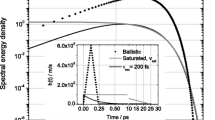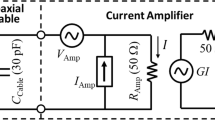Abstract
The noise performance of photoconductive terahertz detectors is analyzed and the tradeoff between low-noise and high-responsivity operation of photoconductive detectors is investigated as a function of device parameters and operational settings. The analysis is conducted on two general photoconductive detector architectures, symmetrically pumped and asymmetrically pumped photoconductive detector architectures. The results indicate that the highest signal-to-noise ratios are offered by the symmetrically pumped and asymmetrically pumped detector architectures for the photoconductive detectors based on short-carrier lifetime and long-carrier lifetime semiconductors, respectively.




Similar content being viewed by others
References
S. Preu, G. H. Dohler, S. Malzer, L. J. Wang, and A. C. Gossard, J. Appl. Phys. 109, 061301 (2011).
J. E. Bjarnason, T. L. J. Chan, A. W. M. Lee, E. R. Brown, D. C. Driscoll, M. Hanson, A. C. Gossard, and R. E. Muller, Appl. Phys. Lett. 85, 3983–3985 (2004).
E. Peytavit, S. Lepilliet, F. Hindle, C. Coinon, T. Akalin, G. Ducournau, G. Mouret, and J.-F. Lampin, Appl. Phys. Lett. 99, 223508 (2011).
P. C. Upadhya, W. Fan, A. Burnett, J. Cunningham, A. G. Davies, E. H. Linfield, J. Lloyd-Hughes, E. Castro-Camus, M. B. Johnston, and H. Beere, Opt. Lett. 32, 2297–2299 (2007).
H. Roehle, R. J. B. Dietz, H. J. Hensel, J. Böttcher, H. Künzel, D. Stanze, M. Schell, and B. Sartorius, Opt. Express 18, 2296–2301 (2010).
Z. D. Taylor, E. R. Brown, and J. E. Bjarnason, Opt Lett. 31, 1729–1731 (2006).
S.-G. Park, K. H. Jin, M. Yi, J. C. Ye, J. Ahn, and K.-H. Jeong, ACS Nano 6, 2026–2031 (2012).
D. H. Auston, K. P. Cheung, and P. R. Smith, Appl. Phys. Lett 45, 284–286 (1984).
M. Beck, H. Schafer, G. Klatt, J. Demsar, S. Winnerl, M. Helm, and T. Dekorsy, Opt. Express 18, 9251–9257 (2010).
M. Jarrahi, and T. H. Lee, Proc. Int. Microwave Symp 1 . 391–394 (2008).
M. Jarrahi, Photon. Technol. Lett. 21, 2019620 (2009).
T. Hattori, K. Egawa, S. I. Ookuma, and T. Itatani, Jpn. J. Appl. Phys. 45, L422-L424 (2006).
J. H. Kim, A. Polley, and S. E. Ralph, Opt. Lett 30, 2490–2492 (2005).
C. W. Berry, N. Wang, M. R. Hashemi, M. Unlu, and M. Jarrahi, Nature Commun. 4, 1622, doi: 10.1038/ncomms2638 (2013).
C. W. Berry, and M. Jarrahi, New J. Phys. 14, 105029 (2012).
C. W. Berry, M. R. Hashemi, M. Unlu, and M. Jarrahi, J. Visualized Experiments, 2013 (in press)
P. R. Smith, D. H. Auston, and M. C. Nuss, IEEE J. Quantum Electron. 24, 255 (1988).
M. van Exter, and D. Grischkowsky, IEEE Trans. Microwave Theory Tech. 38, 1684 (1990).
Y. Cai, I. Brener, J. Lopata, J. Wynn, L. Pfeiffer, J. B. Stark, Q. Wu, X.-C. Zhang, and J. F. Federici, Appl. Phys. Lett 73, 444–446 (1998).
F. G. Sun, G. A. Wagoner, and X.-C. Zhang, Appl. Phys. Lett.67, 1656–1658 (1995).
J. F. O’Hara, J. M. O. Zide, A. C. Gossard, A. J. Taylor, and R. D. Averitt, Appl. Phys. Lett 88, 251119 (2006).
M. Tani, K.-S. Lee, and X.-C. Zhang, Appl. Phys. Lett 77, 1396–1398 (2000).
T.-A. Liu, M. Tani, M. Nakajima, M. Hangyo, and C.-L. Pan, Appl. Phys. Lett. 83, 1322–1324 (2003).
M. Suzuki, and M. Tonouchi, Appl. Phys. Lett 86, 163504 (2005).
T. Kataoka, K. Kajikawa, J. Kitagawa, Y. Kadoya, and Y. Takemura, Appl. Phys. Lett 97, 201110 (2010).
T.-A. Liu, M. Tani, M. Nakajima, M. Hangyo, K. Sakai, S.-I. Nakashima, and C.-L. Pan, Opt. Express 12, 2954–2959 (2004).
E. Castro-Camus, J. Lloyd-Hughes, M. B. Johnston, M. D. Fraser, H. H. Tan, and C. Jagadish, Appl. Phys. Lett 86, 254102 (2005).
F. Peter, S. Winnerl, S. Nitsche, A. Dreyhaupt, H. Schneider and M. Helm, Appl. Phys. Lett 91, 40–42 (2007).
S. Liu, X. Shou, and A. Nahata, IEEE Trans. Terahertz Sci. Technol 1, 412–415 (2011).
B. Heshmat, H. Pahlevaninezhad, Y. Pang, M. Masnadi-Shirazi, R. B. Lewis, T. Tiedje, R. Gordon, and T. E. Darcie, Nano Lett. 12, 6255–6259 (2012).
N. Wang, M. R. Hashemi, and M. Jarrahi, Opt. Express (in press)
S. M. Duffy, S. Verghese, K. A. McIntosh, A. Jackson, A. C. Gossard, and S. Matsuura, IEEE Trans. Microwave Theory Tech. 49, 1032–1038 (2001).
E. R. Brown, Int. J. High Speed Electronics and Systems 13, 497–545 (2003).
E. R. Brown, F. W. Smith, and K. A. McIntosh, J. Appl. Phys. 73, 1480–1484 (1993).
L. Hou, W. Shi, and S. Chen, IEEE J. Selected Topics in Quantum Electronics 19, 8401305 (2013).
S. Gregory, C. Baker, W. R. Tribe, I. V. Bradley, M. J. Evans, E. H. Linfield, A. G. Davies, and M. Missous, IEEE J. Quantum Electron. 41, 717–728 (2005).
C. W. Berry, and M. Jarrahi, J. Infrared, Millimeter & Terahertz Waves 33, 1182–1189 (2012).
P. Uhd Jepsen, R. H. Jacobsen, and S. R. Keiding, J. Opt. Soc. Am. B 13, 2424–2436 (1996).
Z. Piao, M. Tani, and K. Sakai, Jpn. J. Appl. Phys 39, 96–100 (2000).
K. Ezdi, B. Heinen, C. Jordens, N. Vieweg, N. Krumbholz, R. Wilk, M. Mikulics, and M. Koch, J. European Opt. Soc. 4, 09001 (2009).
J. Johnson, Phys. Rev 32, 97 (1928).
H. Nyquist, Phys. Rev 32, 110 (1928).
Acknowledgements
The authors gratefully acknowledge the financial support from the National Science Foundation CAREER Award (contract # N00014-11-1-0096), the Office of Naval Research (contract # N00014-11-1-0096), the Office of Naval Research Young Investigator Award (contract # N00014-12-1-0947), and the Army Research Office Young Investigator Award (contract # W911NF-12-1-0253).
Author information
Authors and Affiliations
Corresponding author
APPENDIX A: Derivation of the diffusion photocurrent in asymmetrically pumped photoconductive detectors
APPENDIX A: Derivation of the diffusion photocurrent in asymmetrically pumped photoconductive detectors
The average diffusion photocurrent induced in the absence of the incident terahertz radiation as the result of the asymmetric optical pumping is calculated using the continuity equations. For this derivation, we assume an ohmic contact between the photoconductor contact electrodes and the photo-absorbing semiconductor. The continuity equations determine the dependence of the photo-generated carrier density as a function of distance from the interface between the semiconductor and contact electrodes, x, in steady state conditions:
where D n (= μ n kT/q) and D P (= μ p kT/q) are electron and hole diffusion constants in the photo-absorbing semiconductor, respectively. Assuming the carrier density at the interface between the semiconductor and contact electrodes approaches its thermal equilibrium value, the steady state photo-generated carrier density as a function of distance from the interface between the semiconductor and contact electrodes is calculated as
Therefore, the induced average diffusion photocurrent at the semiconductor contact interface can be calculated accordingly:
Rights and permissions
About this article
Cite this article
Wang, N., Jarrahi, M. Noise Analysis of Photoconductive Terahertz Detectors. J Infrared Milli Terahz Waves 34, 519–528 (2013). https://doi.org/10.1007/s10762-013-9995-1
Received:
Accepted:
Published:
Issue Date:
DOI: https://doi.org/10.1007/s10762-013-9995-1




